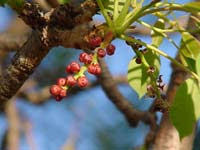Watching the mongooses forage today was a real joy.
You may wonder what's so appealing about small animals crunching up spiders, gnawing squealing rain frogs or licking larvae-innards from their whiskers, but at this time of the year (the close of the wet season) the mongooses are feasting on grasshoppers.
I must admit, though, that dwarf mongooses aren't the most efficient grasshopper-catchers. The insect usually manages two or three good hops before the mongoose gets its paws on it. So accompanying Halcyon group this morning was like stumbling into the middle of an acrobatics troop on speed. There were mongooses flying everywhere; erratically bounding back and forth through the grass, leaping a metre up into the air, or dangling precariously from trees and shrubs.
Amid all this frantic chaos, I noticed something strange. There were no drongos.
Fork-tailed drongo (Dicrurus adsimilis). Photo borrowed from here.
Now, dwarf mongooses usually forage in the company of birds, and their most favoured companion is the fork-tailed drongo (Dicrurus adsimilis). These black, shrike-like birds often escort mammals and ground-foraging birds, fluttering about, snatching up the insects they flush. You can see them following elephants or impala, babblers or buffalo weavers. But their relationship with mongooses seems to be two-way. Each day the mongooses go out of their way to find, and follow, the resident drongos.
Why? Well dwarf mongooses are highly vulnerable to predators. Being small (250g) and foraging by day, they're a source of culinary interest to more than 25 local raptor species. To counter this, the mongooses take turns as sentinels, climbing high up on a tree or boulder to sit and watch for predators while the group forages. They also indulge in eavesdropping. If one of their feathered companions should utter so much as a peep of alarm, the whole group races for safety. Is this why they like drongos?
Chlorophyll (HM004) on sentinel duty.
To find out if the mongooses felt safer when drongos were present, I recorded how often the groups mounted sentinels when a drongo was there, compared with when it wasn't; and a student (from Stellenbosch University) monitored how frequently individual mongooses interrupted their foraging to look around for danger. We found that the mongooses halved both these behaviours when drongos were present. But were the drongos actually causing this change? Perhaps drongos only escorted the mongooses when birds of prey were scarce and the mongooses didn't need caution.
To test this, we artificially simulated the presence of a drongo by playing recordings of its territorial calls. We also played to the mongooses recordings of the white-bellied sunbird (Cinnyris venusta). This beautiful little bird is very common at the study site, but it never accompanies the mongooses.
What happened? The mongooses didn't change their behaviour at all in response to sunbird calls, but when they heard the drongo calls, they visibly relaxed and halved their rate of vigilance. This makes it clear that they really were relying on the drongo to help detect danger.
So why weren't Halcyon foraging with drongos today? I heard the resident drongos calling in the distance, but the mongooses simply ignored them. Fork-tailed drongos, of course, are wickedly efficient at capturing insects on the wing. Once a grasshopper gets airborne in the presence of a drongo, its fate is sealed. I suppose if I was a short-legged mongoose who needed three tries to land a grasshopper, I wouldn't be too keen on having a drongo hanging about either. It just shows, there are times when even your friends aren't welcome...
White-bellied sunbird (Cinnyris venusta).
One of the many golden orb-web spiders (Nephila senegalensis) enjoying the abundance of grasshoppers.
Sharpe, L. L., Joustra, A. S. & Cherry M. I. 2010. The presence of an avian co-forager reduces vigilance in a cooperative mammal. Biology Letters. Published online 3 February. doi: 10.1098/rsbl.2009.1016.

















.JPG)

.JPG)










